Abstract
OBJECTIVE: The purpose of this study was to assess the efficacy of Borg's rating of perceived exertion (RPE) scale to predict maximal exercise levels to control exercise intensity in patients taking atenolol for the treatment of essential hypertension. Normally, a standard formula (220-age) is used for calculating a percentage of exercise intensity, but beta blockade can cause reductions in maximal heart rate of between 20 and 30%. METHODS: Patients were split into a control group-10 men and 10 women, aged 50 (SD 12) and 46 (9) respectively, who had risk factors for cardiovascular disease but were not taking any drugs, and a treatment group-11 men and 11 women, aged 53 (13) and 55 (13) respectively, who were established on 25-100 mg of atenolol. All patients performed two submaximal tests on a cycle ergometer. Test 1 was an estimation test, during which the RPE was reported for each increment in work rate. Test 2 was an RPE production test, during which the patient regulated the work rate according to his/her perception of effort at four predetermined points on the RPE scale (RPE 9, 13, 15, 17). RESULTS: In both tests the individual correlations (r) between RPE, heart rate, and work rate ranged from 0.96 to 0.99. Analysis of variance showed no significant difference in maximal heart rate and maximal power output for the control group when predicted from the regression lines of RPE versus heart rate and RPE versus power output in the estimation test. However, the prediction of maximal power output was lower in the women in the control group and patients in the treatment group when this was predicted from the effort production protocol (P < 0.01). When exercise intensity at each RPE was expressed relative to maximal power output there were no differences between treatment and control groups. CONCLUSION: The findings from this study confirmed the strong positive relation between RPE, heart rate, and work rate in these patients in both passive effort estimation and active effort production protocols. However, caution in applying these procedures is required because the prediction of maximal exercise levels may be lower when effort production procedures are used.
Full text
PDF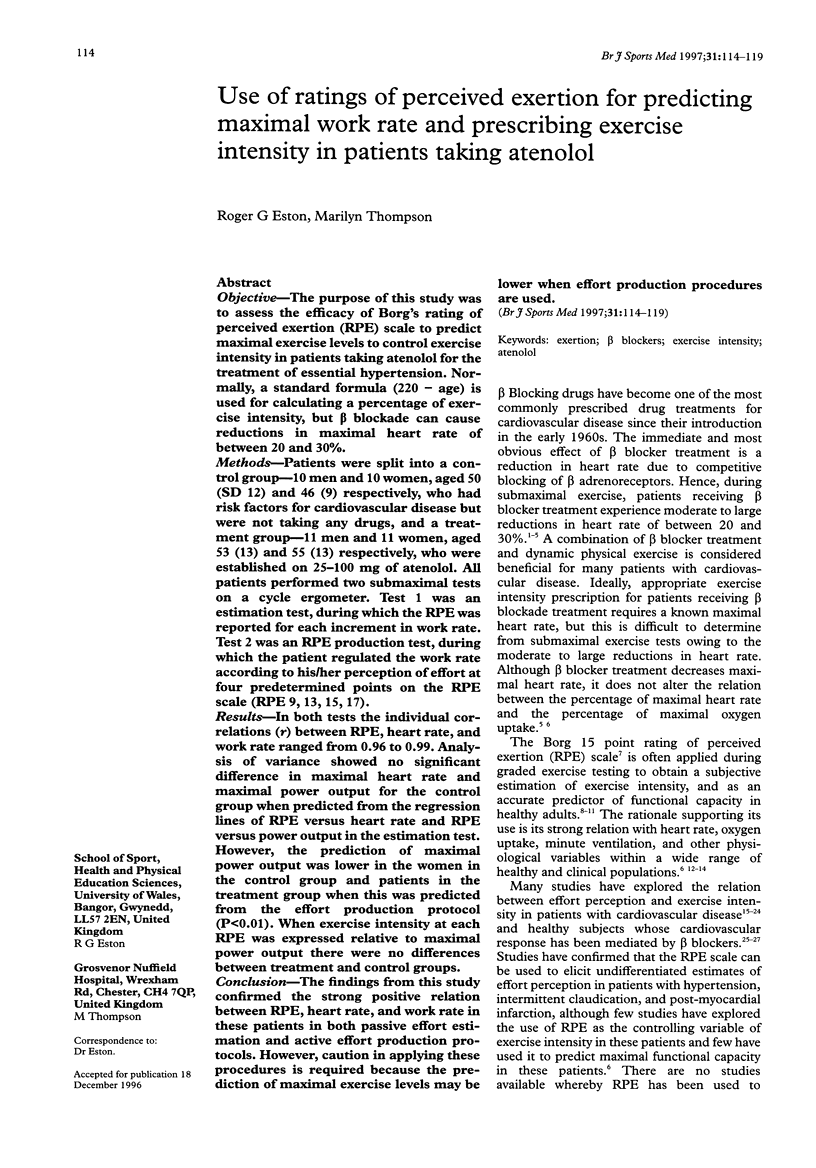
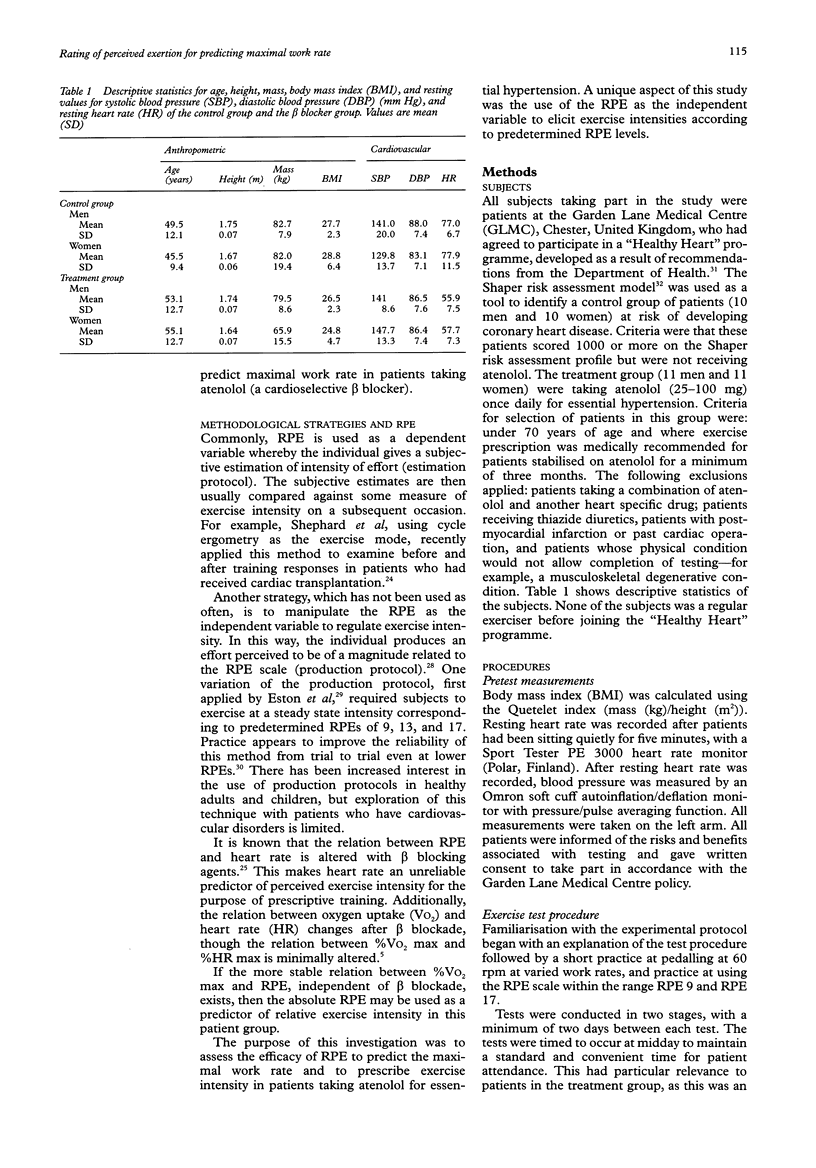

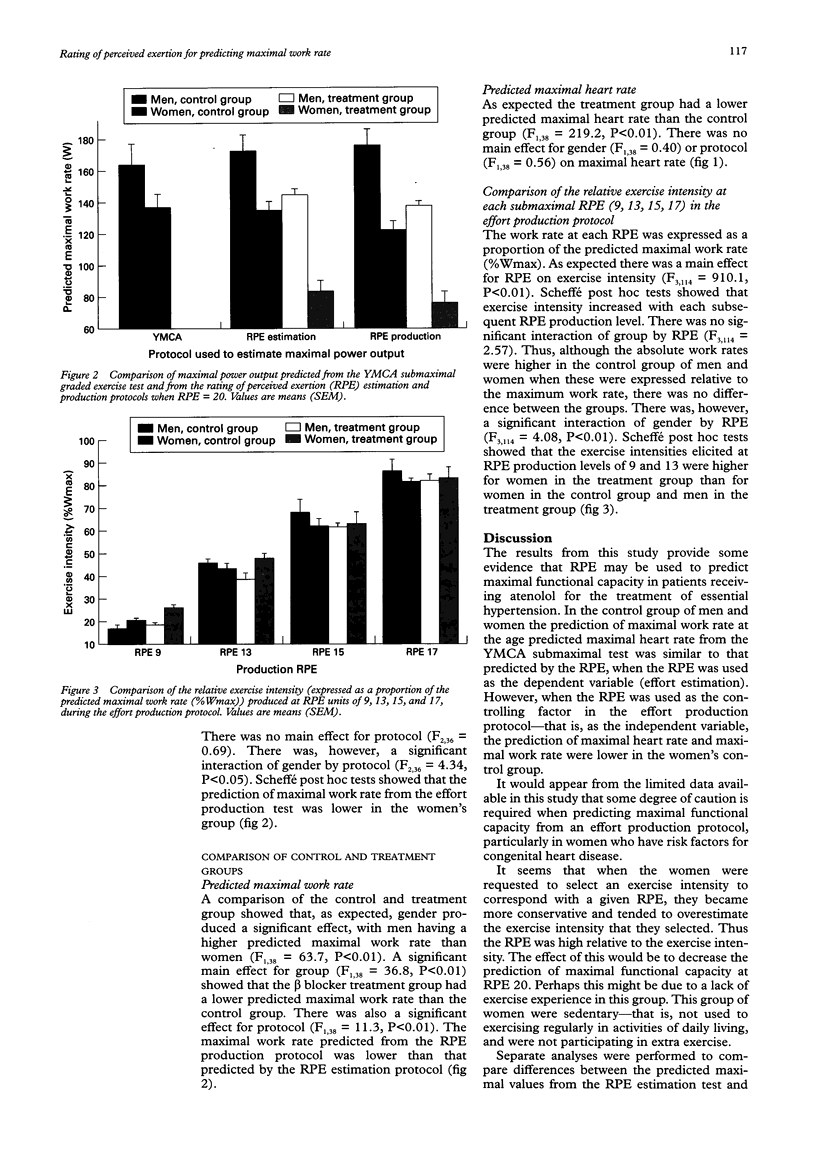
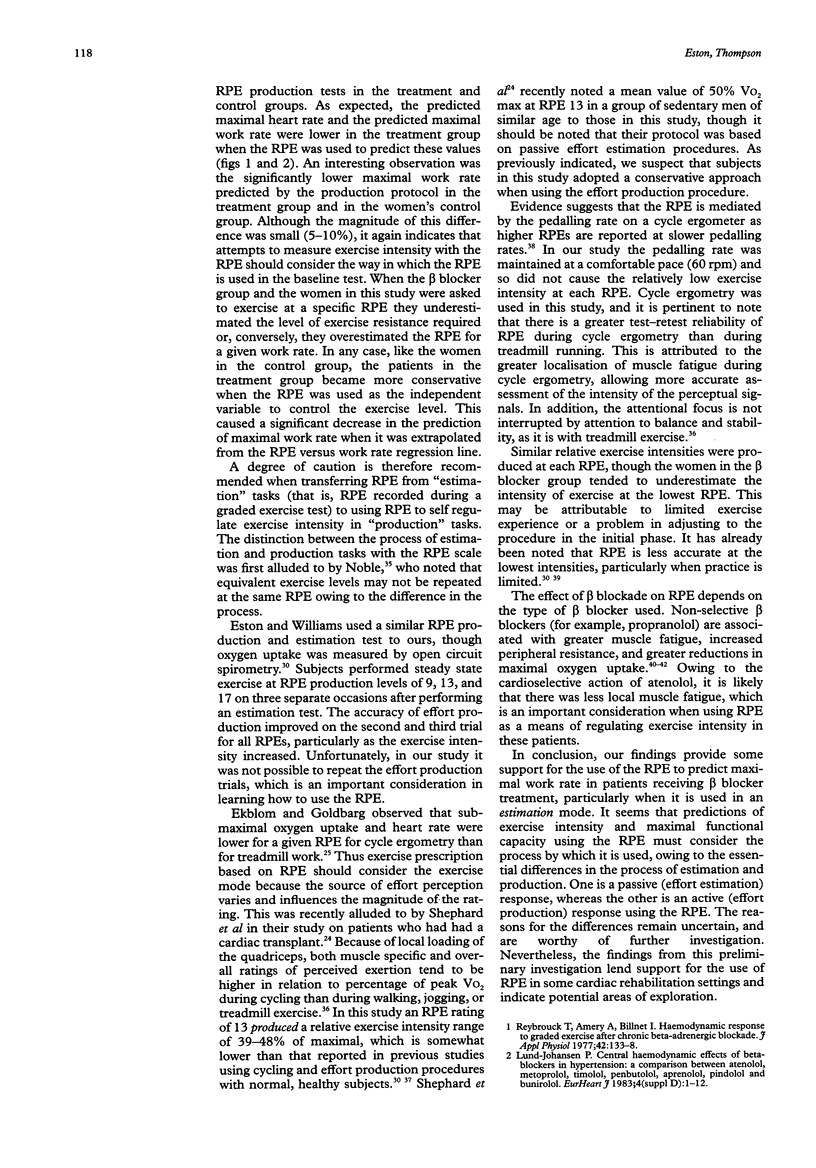
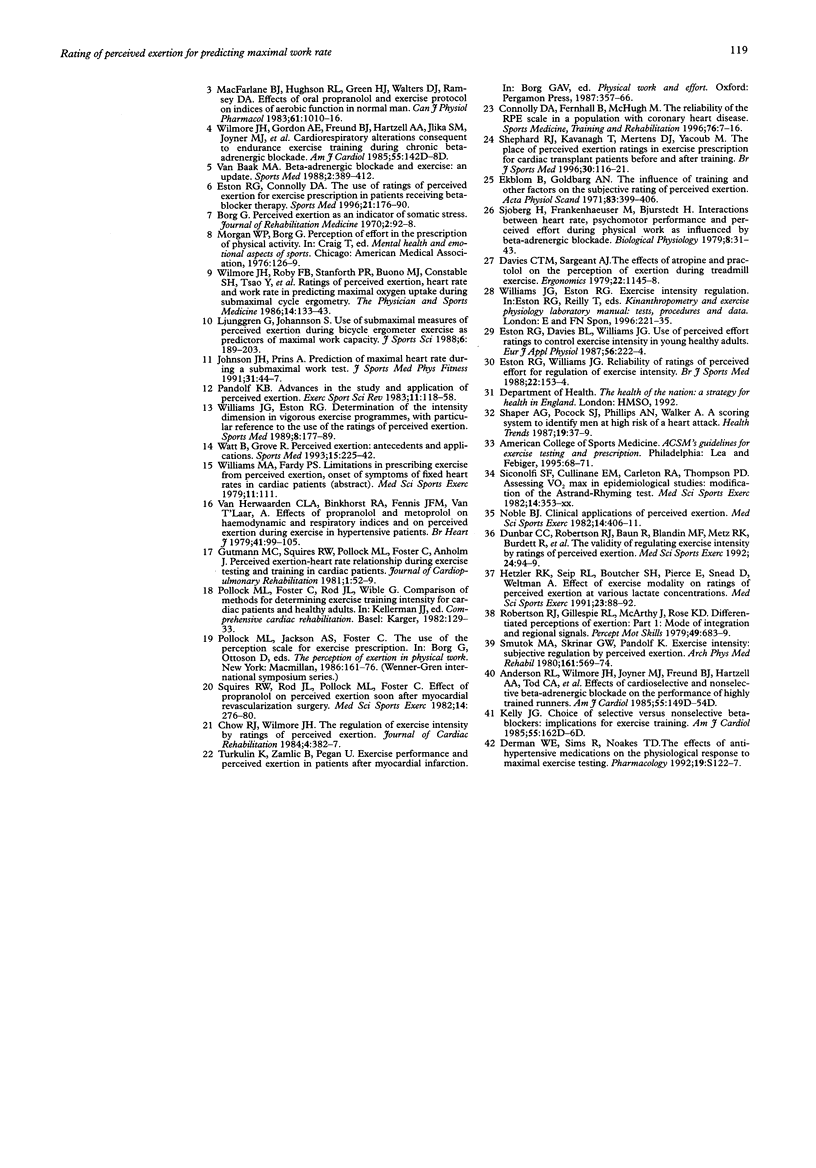
Images in this article
Selected References
These references are in PubMed. This may not be the complete list of references from this article.
- Borg G. Perceived exertion as an indicator of somatic stress. Scand J Rehabil Med. 1970;2(2):92–98. [PubMed] [Google Scholar]
- Derman W. E., Sims R., Noakes T. D. The effects of antihypertensive medications on the physiological response to maximal exercise testing. J Cardiovasc Pharmacol. 1992;19 (Suppl 5):S122–S127. [PubMed] [Google Scholar]
- Dunbar C. C., Robertson R. J., Baun R., Blandin M. F., Metz K., Burdett R., Goss F. L. The validity of regulating exercise intensity by ratings of perceived exertion. Med Sci Sports Exerc. 1992 Jan;24(1):94–99. [PubMed] [Google Scholar]
- Eston R. G., Davies B. L., Williams J. G. Use of perceived effort ratings to control exercise intensity in young healthy adults. Eur J Appl Physiol Occup Physiol. 1987;56(2):222–224. doi: 10.1007/BF00640648. [DOI] [PubMed] [Google Scholar]
- Eston R. G., Williams J. G. Reliability of ratings of perceived effort regulation of exercise intensity. Br J Sports Med. 1988 Dec;22(4):153–155. doi: 10.1136/bjsm.22.4.153. [DOI] [PMC free article] [PubMed] [Google Scholar]
- Eston R., Connolly D. The use of ratings of perceived exertion for exercise prescription in patients receiving beta-blocker therapy. Sports Med. 1996 Mar;21(3):176–190. doi: 10.2165/00007256-199621030-00003. [DOI] [PubMed] [Google Scholar]
- Garhammer J. Energy flow during Olympic weight lifting. Med Sci Sports Exerc. 1982;14(5):353–360. [PubMed] [Google Scholar]
- Hetzler R. K., Seip R. L., Boutcher S. H., Pierce E., Snead D., Weltman A. Effect of exercise modality on ratings of perceived exertion at various lactate concentrations. Med Sci Sports Exerc. 1991 Jan;23(1):88–92. [PubMed] [Google Scholar]
- Ljunggren G., Johansson S. E. Use of submaximal measures of perceived exertion during bicycle ergometer exercise as predictors of maximal work capacity. J Sports Sci. 1988 Winter;6(3):189–203. doi: 10.1080/02640418808729809. [DOI] [PubMed] [Google Scholar]
- MacFarlane B. J., Hughson R. L., Green H. J., Walters D. J., Ranney D. A. Effects of oral propranolol and exercise protocol on indices of aerobic function in normal man. Can J Physiol Pharmacol. 1983 Sep;61(9):1010–1016. doi: 10.1139/y83-151. [DOI] [PubMed] [Google Scholar]
- Noble B. J. Clinical applications of perceived exertion. Med Sci Sports Exerc. 1982;14(5):406–411. doi: 10.1249/00005768-198205000-00016. [DOI] [PubMed] [Google Scholar]
- Pandolf K. B. Advances in the study and application of perceived exertion. Exerc Sport Sci Rev. 1983;11:118–158. [PubMed] [Google Scholar]
- Pollock M. L., Foster C., Rod J. L., Wible G. Comparison of methods for determining exercise training intensity for cardiac patients and healthy adults. Adv Cardiol. 1982;31:129–133. doi: 10.1159/000407132. [DOI] [PubMed] [Google Scholar]
- Robertson R. J., Gillespie R. L., McCarthy J., Rose K. D. Differentiated perceptions of exertion: part I. mode of integration of regional signals. Percept Mot Skills. 1979 Dec;49(3):683–689. doi: 10.2466/pms.1979.49.3.683. [DOI] [PubMed] [Google Scholar]
- Shaper A. G., Pocock S. J., Phillips A. N., Walker M. A scoring system to identify men at high risk of a heart attack. Health Trends. 1987 May;19(2):37–39. [PubMed] [Google Scholar]
- Shephard R. J., Kavanagh T., Mertens D. J., Yacoub M. The place of perceived exertion ratings in exercise prescription for cardiac transplant patients before and after training. Br J Sports Med. 1996 Jun;30(2):116–121. doi: 10.1136/bjsm.30.2.116. [DOI] [PMC free article] [PubMed] [Google Scholar]
- Sjöberg H., Frankenhaeuser M., Bjurstedt H. Interactions between heart rate, psychomotor performance and perceived effort during physical work as influenced by beta-adrenergic blockade. Biol Psychol. 1979 Feb;8(1):31–43. doi: 10.1016/0301-0511(79)90003-6. [DOI] [PubMed] [Google Scholar]
- Smutok M. A., Skrinar G. S., Pandolf K. B. Exercise intensity: subjective regulation by perceived exertion. Arch Phys Med Rehabil. 1980 Dec;61(12):569–574. [PubMed] [Google Scholar]
- Squires R. W., Rod J. L., Pollock M. L., Foster C. Effects of propranolol on perceived exertion soon after myocardial revascularization surgery. Med Sci Sports Exerc. 1982;14(4):276–280. doi: 10.1249/00005768-198204000-00004. [DOI] [PubMed] [Google Scholar]
- Watt B., Grove R. Perceived exertion. Antecedents and applications. Sports Med. 1993 Apr;15(4):225–241. doi: 10.2165/00007256-199315040-00002. [DOI] [PubMed] [Google Scholar]
- Williams J. G., Eston R. G. Determination of the intensity dimension in vigorous exercise programmes with particular reference to the use of the rating of perceived exertion. Sports Med. 1989 Sep;8(3):177–189. doi: 10.2165/00007256-198908030-00004. [DOI] [PubMed] [Google Scholar]
- van Herwaarden C. L., Binkhorst R. A., Fennis J. F., van't Laar A. Effects of propranolol and metoprolol on haemodynamic and respiratory indices and on perceived exertion during exercise in hypertensive patients. Br Heart J. 1979 Jan;41(1):99–105. doi: 10.1136/hrt.41.1.99. [DOI] [PMC free article] [PubMed] [Google Scholar]





